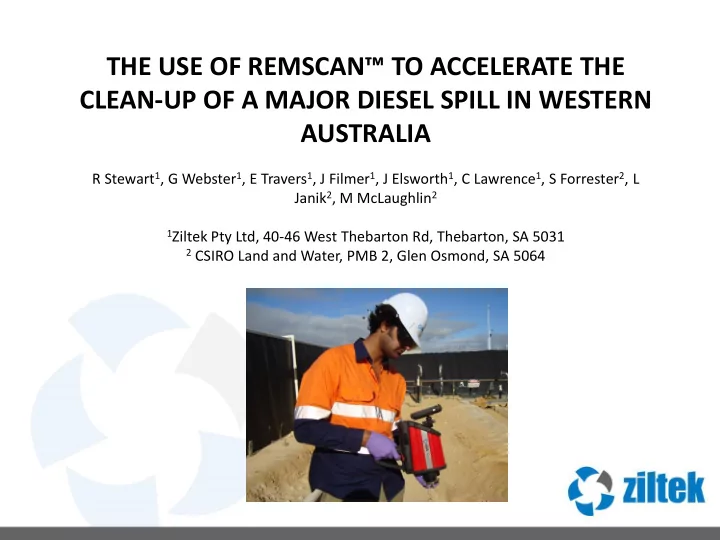

THE USE OF REMSCAN ™ TO ACCELERATE THE CLEAN-UP OF A MAJOR DIESEL SPILL IN WESTERN AUSTRALIA R Stewart 1 , G Webster 1 , E Travers 1 , J Filmer 1 , J Elsworth 1 , C Lawrence 1 , S Forrester 2 , L Janik 2 , M McLaughlin 2 1 Ziltek Pty Ltd, 40-46 West Thebarton Rd, Thebarton, SA 5031 2 CSIRO Land and Water, PMB 2, Glen Osmond, SA 5064
What is RemScan? • Handheld infrared instrument for the direct measurement of TPH in soil • User simply pulls the trigger for a 15 second readout of TPH (C 10 - C 36 ) in mg/kg • No consumables or chemicals required
Diesel Spill at Tank Farm Site, WA
The Spill Response • Project under a high level of scrutiny • Sensitive surrounding environment • Ongoing investigation • Required rapid response • Minimise risk of further release • Avoid storm water impacts • Clean up criteria • 400 mg/kg TPH (C 10 to C 36 ) • Total removal of impacted materials
Clean Up Validation • Ziltek was engaged to supply and operate a RemScan unit to assist site validation works by: • Accelerating project closure - same day decisions • Increasing confidence - more data • Minimising lab costs – accurate screening tool • It was decided to build a site-specific calibration model in the RemScan unit to: • Reduce soil interferences (e.g. carbonates) • Lower detection limit
Building a Site Specific Calibration Collect 36 samples from site Scan using RemScan (5x) Infrared spectra Build model NATA lab analysis TPH Data Load RemScan *Entire process completed in 5 days
Cross Validation of RemScan versus Lab 35,000 30,000 Detection limit = 78 mg/kg R 2 = 0.997 RemScan TPH concentration (mg/kg) Relative error <10% 25,000 20,000 15,000 10,000 5,000 0 0 5,000 10,000 15,000 20,000 25,000 30,000 35,000 NATA accredited lab TPH concentration (mg/kg)
Site Validation Process
Independent RemScan Verification • The environmental superintendent selected 19 blind samples for verification • The samples were measured on site using RemScan and then sent for NATA laboratory analysis • Each samples was scanned 5 times and the average was compared with lab data
Cross Validation of RemScan versus Lab 35,000 30,000 RemScan TPH concentration (mg/kg) 25,000 20,000 15,000 10,000 5,000 0 0 5,000 10,000 15,000 20,000 25,000 30,000 35,000 NATA accredited lab TPH concentration (mg/kg)
Cross Validation of RemScan versus Lab 35,000 35,000 30,000 30,000 RemScan TPH concentration (mg/kg) RemScan TPH concentration (mg/kg) 25,000 25,000 20,000 20,000 15,000 15,000 10,000 10,000 5,000 5,000 0 0 0 0 5,000 5,000 10,000 10,000 15,000 15,000 20,000 20,000 25,000 25,000 30,000 30,000 35,000 35,000 NATA accredited lab TPH concentration (mg/kg) NATA accredited lab TPH concentration (mg/kg)
Project Outcomes • Site specific calibration developed in 5 days • Detection limit of 78 mg/kg TPH C 10 -C 36 • Relative error <10% • Completed site validation works in 4 days • Cost savings estimated by client at >$30,000 • RemScan sets a new precedent for rapid screening of TPH in soil
Technology Partners This project has been supported with assistance from the Australia Government through Commercialisation Australia.
Recommend
More recommend